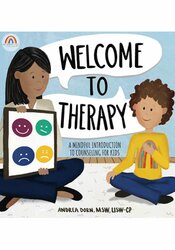3 Tips for Introducing Kids to Therapy Using the A.C.E. Approach

Starting therapy can be a challenging and confusing experience, especially for children. They often don’t know what to expect, who a therapist is, or how therapy can help. Whether they’re going to therapy to navigate grief, sadness, anxiety, trauma, or other tricky situations, it’s important that children understand the ins and outs of therapy to start off on the right foot.
And as therapists, you can help guide parents in the right direction. A.C.E. is a practical approach to sharing new information with children. Share the A.C.E. approach below with the families you work with to better navigate transitions like going to therapy and share information in a helpful way.
Helping children understand what to expect is an important way to maintain a sense of security and felt-safety when doing something new. By approaching the topic with sensitivity and openness, you lay the foundation for a positive and beneficial therapeutic journey for your whole family.
Watch this video where I explain how therapists and caregivers can use the A.C.E. approach to introduce kids to therapy, plus a FREE guide you can print at home or in the office, too!
And as therapists, you can help guide parents in the right direction. A.C.E. is a practical approach to sharing new information with children. Share the A.C.E. approach below with the families you work with to better navigate transitions like going to therapy and share information in a helpful way.
Assess
Assess your beliefs and feelings surrounding therapy and your chil'd mental health challenges. This will help you work towards shifting or neutralizing negative believs and regulating overwhelming emotions.Communicate
Communicate using age-appropriate and developmentally-appropriate information. You'll want to consider when to share and how much to share. Then, you'll ask about what they already know and fill in the gaps with who, what, where, why, and when.Engage
Engage children in activities that foster understanding of what therapy entails with repitition, informal play, and talking.Helping children understand what to expect is an important way to maintain a sense of security and felt-safety when doing something new. By approaching the topic with sensitivity and openness, you lay the foundation for a positive and beneficial therapeutic journey for your whole family.
Watch this video where I explain how therapists and caregivers can use the A.C.E. approach to introduce kids to therapy, plus a FREE guide you can print at home or in the office, too!
How do I teach my child that it’s safe to share their feelings with a trusted adult?

Starting therapy can be a challenging and confusing experience, especially for children. They often don’t know what to expect, who a therapist is, or how therapy can help. Whether they’re going to therapy to navigate grief, sadness, anxiety, trauma, or other tricky situations, it’s important that children understand the ins and outs of therapy to start off on the right foot.
Written and illustrated by therapist (and mother) Andrea Dorn, MSW, LISW-CP, Welcome to Therapy walks children through the process of starting therapy and normalizes the experience in simple, concrete, and developmentally appropriate terms – allowing kids to better understand what to expect and what is expected of them.
Written and illustrated by therapist (and mother) Andrea Dorn, MSW, LISW-CP, Welcome to Therapy walks children through the process of starting therapy and normalizes the experience in simple, concrete, and developmentally appropriate terms – allowing kids to better understand what to expect and what is expected of them.
Meet the Expert:
Andrea Dorn, MSW, LISW-CP, is a mom and licensed clinical social worker who works as a psychotherapist with adults and children of all ages. The Mindful Steps series was created as a culmination of her interest and background in mindfulness as well as behavioral and attachment theories. Andrea is dedicated to helping young minds and their families navigate the big and small changes that come with child development by encouraging mindfulness and emotional connection.
Learn more about her educational products, including upcoming live seminars, by clicking here.
Learn more about her educational products, including upcoming live seminars, by clicking here.



